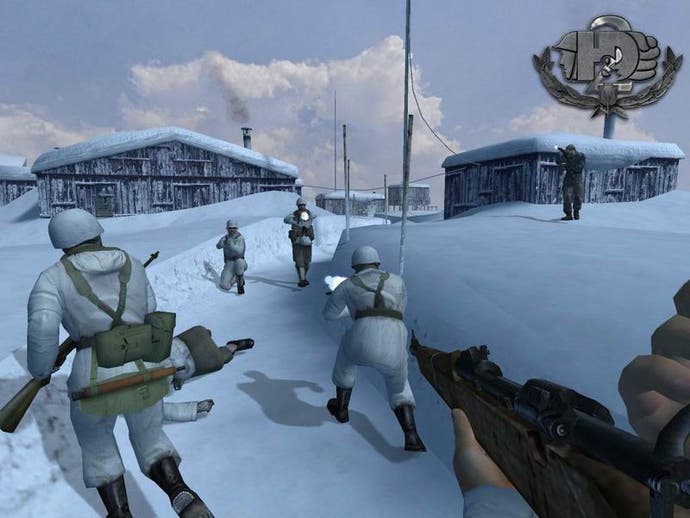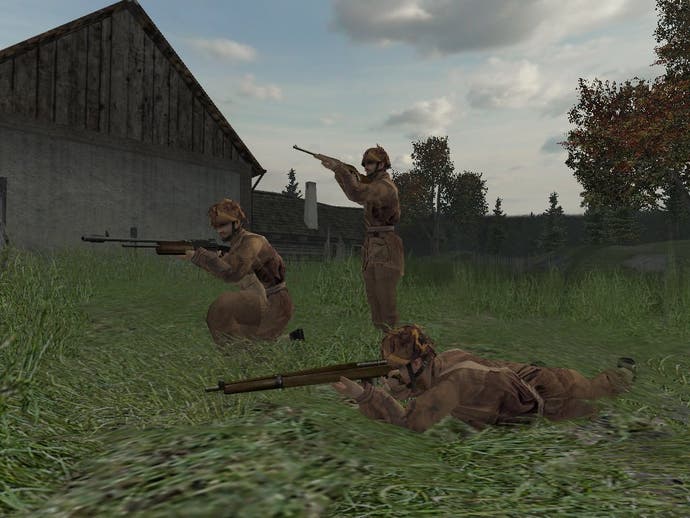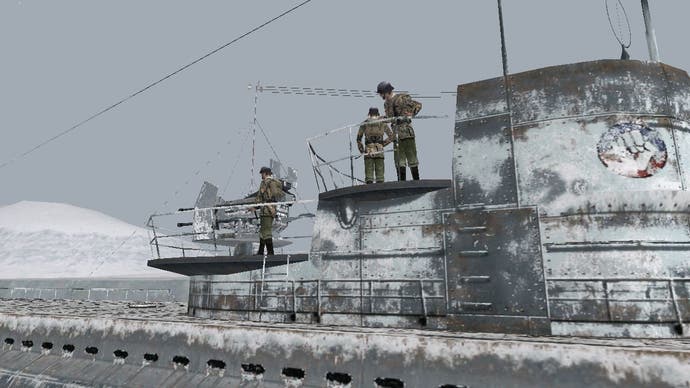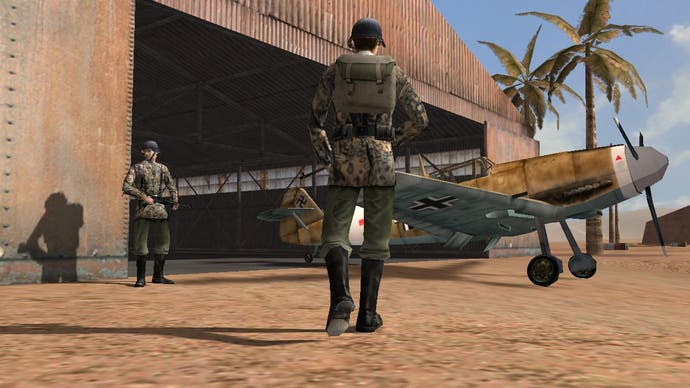Hidden & Dangerous II
Kristan braves the battlefields of Windsor to find out how Illusion's been getting on...
While everyone has been getting their knickers caught up in the will-they-won't-they illusion that a certain shoot 'em up based in the ruins of Eastern Europe is going to be released on September 30th, lauded Eastern European coders at Illusion have been busy putting the finishing touches to their long-awaited follow-up to Hidden & Dangerous.
Having always admired the squad-based atmospherics of the original World War II tactical stealth action classic, Eurogamer was eager to get a proper hands-on after snatching various tempting glimpses of the game over the past two and a half years. Tearing down the M4 to Gathering's Windsor HQ, we managed to creep through the first two (of 20) levels, based in the icy wastes of the Arctic.
Multi-tentacled

For those of you coming to H&D II fresh, it's a multi-faceted tactical action game set throughout the various theatres of war encompassing Europe, Africa and Asia, and pretty much allows you to play it the way you want to. The old style four-man SAS squad-based gameplay remains, but Illusion has also ambitiously allowed players to switch to an easy to manipulate, tactical RTS mode, as well as the standard third person view, and an FPS-style first-person perspective. Which viewpoint you choose - and when - will be left up to you, but you'll quickly find out that each has its own pros and cons.
Better still, there's now a Lone Wolf mode, which presents players the option of warmongering alone, thus entirely dispensing with the squad/tactical mechanic in favour of a tense against-the-odds solo battle with the Third Reich. It's this unprecedented degree of flexibility that makes Hidden & Dangerous II stand out as something very special indeed - especially when you get to grips with it and find out for yourself.
The game's first campaign, Operation Snowball, kicks off on the night of March 4th 1941 aboard the wobbly Dacota aircraft, which is being buffeted in the Arctic skies 'like a rag doll'. Parachuting to the drop zone in search of a downed Norwegian pilot, your first task is to meet up with your guide, Sygurd, who shows you the way to the entrance of a top secret aviation factory complex. With squad in tow, your mission is to gain entrance to the underground complex and take out the numerous patrolling Nazi guards and rapid dogs that leap out of the snow.
Pack up your troubles in your old kit bag...

But before you get to tussle with the Axis forces, you have to select the members of your team and kit them out with your weapons of choice. The whole process hasn't changed a great deal since the original, with the option to let the PC choose for you. Naturally, a bit of extra time choosing your men can be worth it if you fancy trawling through all 40. And with Health, Strength, Endurance, Shooting, Stealth, First Aid and Lock Picking skills to take into account, there's plenty to weigh up. Do you bring a pack horse with a dodgy aim, or a strong lock pick? Whatever your choice, if they die in a mission you're sending them home in a box and picking another victim. If it's a specialist, then they're gone forever so it pays to ensure the safety of your men.
Typically, the atmosphere within the missions is unbearable, with death always a matter of seconds away unless you organise yourself well. Even on easy difficulty, it's unlikely you'll be playing this in the manner of a traditional first or third person shooter. Simply put, you'll die very quickly as the enemy is almost always well placed, quick off the draw and deadly with their aim - not to mention that your soft fleshy bodies can't take more than a handful of hits.
In your favour, however, you're granted unlimited saves but only one save slot, meaning you must use it with care, lest you decide to save a split second before a shot enters your skull. It's still not the perfect solution, but it at least cancels out the cheating mechanic of having unlimited save points, while improving on the ostensibly harsh two-save-points method used previously.
Find your path, soldier

One of the noticeable enhancements is the path finding and general AI of your squaddies. However great the first H&D was, it was notorious for being bugged to death and any attempts to plan ahead with the tactical maps were fraught with problems as your drunken goons ran into walls, enemy fire, or any number of hapless situations. Four years of development haven't gone to waste, and it's now perfectly reasonable to assume that your band of brothers will spot enemies nearly all of the time, provide a decent level of cover, adhere to your orders and generally work with you.
Given our limited time with the game, we didn't have an opportunity to get too practiced with the inner workings of the tactical side of the game, but having seen Andy, the producer, give us a guided tour, it's fair to say that the interface is simple, straightforward and anyone used to RTSes will have no problem getting the hang of it. Essentially, entering the game's tactical mode freezes the action and pans the viewpoint out isometrically, allowing you to zoom and rotate to whatever view you require of the proceedings, and a chance to plot the actions of your team via a series of waypoints and actions. Cunningly, any enemies you haven't yet seen won't show up on the map, so there's no means of cheating your way through.
Numerous actions are available to you, such as silent movement, silent attack silent action, attack, take cover, hold position and so on, and it's possible to conjure sophisticated sorties with a minimum degree of fuss. When we get the finished code in a few weeks we'll give this area of the game more attention, but from what we've seen it has been cleanly integrated and should please the strategists among you.
Dib dib dib

For the time being, though, we ploughed on with a mixture of traditional third-person and first-person viewpoint, especially the second mission, Scout, which you play as a lone soldier tasked with some stealthy espionage and, ultimately, demolition.
Entering the aviation research complex, there are numerous options available to you. You can storm in and take out dozens of MP40 wielding guards and scientists, but very quickly it becomes apparent that the panic button alarms bring a posse of guards heading your way. Instead, procuring a Nazi uniform becomes your best method of smooth progression, but simply killing a guard won't work thanks to the blood. After much death, it becomes apparent that forcing a lone guard into surrender is the way forward. A quick uniform switch later, and the disposal of our weapon and backpack and we're fully disguised and able to wander freely among the complex.
Despite your ruse, the Nazi guards are still alert to any suspicious activity, and you'll be rumbled if you spend too long in their company. Encountering one of them results in your 'disguise' bar decreasing slowly, so keeping on the move is the best strategy - or killing them discreetly with a knife to avoid the inevitable noise. Eventually we culled them one by one, dragging their lifeless torsos to a darkened corner to avoid further suspicion, while taking pictures of top secret plans and planting explosive charges to send the whole place up to the heavens.
Picky

At the end of each mission your men receive RPG-style stat upgrades depending on the skills your men have made use of. For example, if you've picked a lot of locks, that area will be upgraded, likewise if you've crippled a solider with their maximum load. In addition your men are also awarded medals for their achievements, like the Military Cross, and presumably other more prestigious lumps of metal.
Visually the game is a pleasing improvement on the original, using a tweaked version of the LS3D engine most recently used in Mafia. Although it's not going to trouble the Source engine for impressive effects, all the locales we saw were rendered with plenty of intricate texture detail, the character models are rich with detail, while the rag doll physics employed ensure that downed soldiers slump to the floor in a convincing fashion. Not only that, but downed enemies don't just disappear into that great gaming graveyard in the CPU. Every killed enemy remains a problem, and getting rid of the evidence is just as important. In every sense, it makes the current No.1, Conflict: Desert Storm II, look years behind by comparison.
But that's H&D II all over. It's a game which sets new gameplay benchmarks in all manner of ways with its superb flexibility and engrossing, tense atmosphere, and will undoubtedly rank among the games of the year come its release on October 24th. We look forward to bringing you our considered single and multiplayer impressions of this impressive game in just a few weeks.

